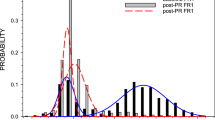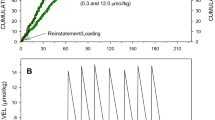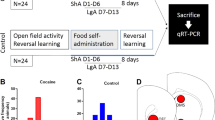Abstract
The effect of intracerebral injections of 5,7-dihydroxy-tryptamine (5,7-DHT) on cocaine self-administration behavior was assessed. Rats were tested on a progressive ratio (PR) schedule for cocaine reinforcement. The first response on the lever each day produced an IV infusion of cocaine (0.6 mg/injection) after which the requirements of the schedule escalated with each reinforcement until the behavior extinguished. The final ratio completed was defined as the breaking point. Bilateral injections of 5,7-DHT into either the medial forebrain bundle (MFB) or amygdala (AMY) significantly increased the breaking points on the PR schedule compared to vehicle-injected control animals. We interpret these data to indicate that depletion of forebrain serotonin increases the incentive value of cocaine.
Similar content being viewed by others
References
Azzaro AJ, Rutledge CO (1973) Selectivity of release of norepinephrine, dopamine, and 5-hydroxytryptamine by amphetamine in various regions of the rat brain. Biochem Pharmacol 22:2801–2813
Chow HL, Beck CHM (1984)p-Chlorophenylalanine andp-chloroamphetamine pretreatment of apomorphine-challenged rats: effect on solitary and social behavior. Eur J Pharmacol 102:297–304
Deminiere JM, Simon H, Herman JP, Le Moal M (1984) 6-Hydroxydopamine lesions of the dopamine mesocorticolimbic cell bodies increases (+)-amphetamine self-administration. Psychopharmacology 83:281–284
Deminiere JM, Taghzouti K, Le Moal M, Simon H (1987) Increased sensitivity to amphetamine and facilitation of amphetamine self-administration after 6-hydroxydopamine lesions of the amygdala. Psychopharmacology 94:232–236
Hodos W (1961) Progressive ratio as a measure of reward strength. Science 134:943–944
Koob GF, Le HT, Creese I (1987) The D1 dopamine receptor antagonist SCH 23390 increases cocaine self-administration in the rat. Neurosci Lett 79:315–320
Korsgaard S, Gerlach J, Christensson E (1985) Behavioral aspects of serotonin-dopamine interactions in the monkey. Eur J Pharmacol 118:245–252
Leccese AP, Lyness WH (1984) The effects of the putative 5-hydroxytryptamine receptor active agents ond-amphetamine self-administration in controls and rats with 5,7-dihydroxytryptamine median forebrain bundle lesions. Brain Res 303:153–162
Lyness WH, Moore KE (1983) Increased self-administration ofd-amphetamine by rats pretreated with metergoline. Pharmacol Biochem Behav 18:721–724
Lyness WH, Friedle NM, Moore KE (1979) Destruction of dopaminergic nerve terminals in nucleus accumbens: effect ond-amphetamine self-administration. Pharmacol Biochem Behav 11:553–556
Lyness WH, Friedle NM, Moore KE (1980) Increased self-administration ofd-amphetamine after destruction of 5-hydroxytryptaminergic neurons. Pharmacol Biochem Behav 12:937–941
Mefford IN (1981) Application of high performance liquid chromatography with electrochemical detection to neurochemical analysis: measurement of catecholamines, serotonin and metabolites the rat brain. J Neurosci Methods 3:207–224
Pettit HO, Ettenburg A, Bloom FE, Koob GF (1984) Destruction of dopamine in the nucleus accumbens selectively attenuates cocaine but not heroin self-administration. Psychopharmacology 84:167–173
Ritz MC, Lamb RJ, Goldberg SR, Kuhar MJ (1987) Cocaine receptors on dopamine transporters are related to the self-administration of cocaine. Science 237:1219–1223
Roberts DCS (1989a) Breaking points on a progressive ratio schedule reinforced by intravenous apomorphine increase daily following 6-hydroxydopamine lesions of the nucleus accumbens. Pharmacol Biochem Behav 32:43–47
Roberts DCS (1989b) Neural substrates mediating cocaine reinforcement: monoamine systems. In: Lakoski JM, Gallaway MP, White FJ (eds) Cocaine: pharmacology, physiology and clinical strategies. The Telford Press, Caldwell (in press)
Roberts DCS, Goeders N (1989) Drug self-administration: experimental methods and determinants. In: Boulton AA, Baker GB, Greenshaw AJ (eds) Neuromethods, vol. 13, Psychopharmacology 1: Psychopharmacology. Humana Press, Clifton, New Jersey (in press)
Roberts DCS, Vickers G (1984) Atypical neuroleptics increase self-administration of cocaine: an evaluation of a behavioural screen for antipsychotic activity. Psychopharmacology 82:135–139
Roberts DCS, Corcoran ME, Fibiger HC (1977) On the role of ascending catecholamine systems in self-administration of cocaine. Pharmacol Biochem Behav 6:615–620
Roberts DCS, Koob GF, Klonoff P, Fibiger HC (1980) Extinction and recovery of cocaine self-administration following 6-hydroxydopamine lesions of the nucleus accumbens. Pharmacol Biochem Behav 12:781–787
Roberts DCS, Bennett SAL, Vickers G (1989a) The estrous cycle affects cocaine self-administration on a progressive ratio schedule in rats. Psychopharmacology 98:408–411
Roberts DCS, Loh EA, Vickers G (1989b) Self-administration of cocaine on a progressive ratio schedule in rats: dose-response relationship and effect of haloperidol pretreatment. Psychopharmacology 97:535–538
Scheel-Krüger J (1972) Behavioral and biochemical comparison of amphetamine derivatives, cocaine, benztropine and tricyclic anti-depressant drugs. Eur J Pharmacol 18:63–73
Smith FL, Yu DSL, Smith DG, Leccese AP, Lyness WH (1986) Dietary tryptophan supplements attenuate amphetamine self-administration in the rat. Pharmacol Biochem Behav 25:849–854
Wilson MC, Schuster CR (1973) Cholinergic influence on intravenous cocaine self-administration in the rhesus monkey. Pharmacol Biochem Behav 1:643–649
Yokel RA, Wise RA (1976) Attenuation of intravenous amphetamine reinforcement by central dopamine blockade in rats. Psychopharmacology 48:311–318
Zito KA, Vickers G, Roberts DCS (1985) Disruption of cocaine and heroin self-administration following kainic acid lesions of the nucleus accumbens. Pharmacol Biochem Behav 23:1029–1036
Author information
Authors and Affiliations
Rights and permissions
About this article
Cite this article
Loh, E.A., Roberts, D.C.S. Break-points on a progressive ratio schedule reinforced by intravenous cocaine increase following depletion of forebrain serotonin. Psychopharmacology 101, 262–266 (1990). https://doi.org/10.1007/BF02244137
Received:
Revised:
Issue Date:
DOI: https://doi.org/10.1007/BF02244137




